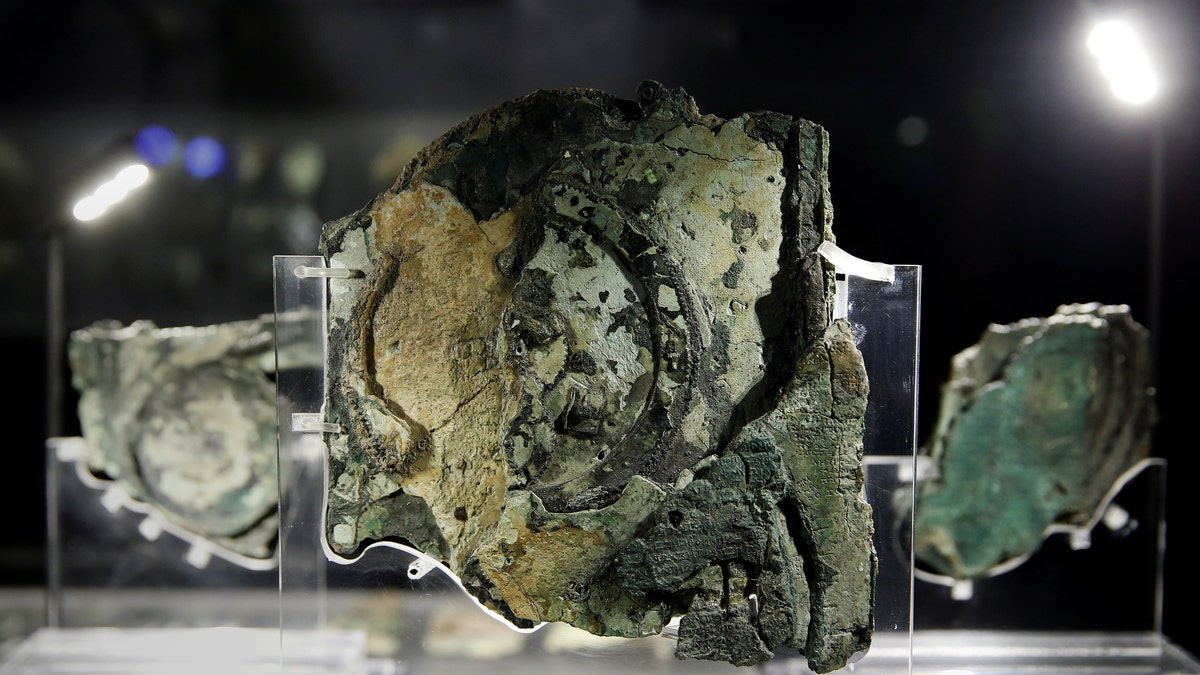
Fragments of the ancient Antikythera Mechanism are displayed at the National Archaeological Museum in Athens, Greece June 9, 2016. (REUTERS/Alkis Konstantinidis)
Thanks to high-tech scanning, 2,000-year-old inscriptions on the Antikythera mechanism, an ancient Greek "computer," can be read more clearly than ever before, revealing more information about the device and its possible uses.
Ever since the first fragments of the device were pulled from a shipwreck off the coast of the Greek island Antikythera in 1901, scientists and historians have been trying to learn more about its purpose. The bronze astronomical calculator was about the size of a shoebox, with dials on its exterior and an intricate system of 30 bronze gear wheels inside. With the turn of a hand crank, the ancient Greeks could track the positions of the sun and the moon, the lunar phases, and even cycles of Greek athletic competitions.
The 82 corroded metal fragments of the Antikythera mechanism contain ancient Greek text, much of which is unreadable to the naked eye. But over the past 10 years, new imaging techniques, such as 3D X-ray scanning, have revealed hidden letters and words in the text.
"Before, we could make out isolated words, but there was a lot of noise —letters that were being misread or gaps in the text," said Alexander Jones, a professor of the history of science at New York University. "Now, we have something that you can actually read as ancient Greek. We can tell what these texts were saying to an ancient observer."
Jones and his colleagues recently published a set of papers on the inscriptions in a special issue of the journal Almagest. The newly filled-in bits of text have allowed Jones and his colleagues to get a better idea of what the machine might have looked like in antiquity. Inscriptions on the cover of the back face of the device, for instance, contain an inventory of all of the dials and what they mean.
"That's where we get the key information that there was a full-blown display of planets moving through the zodiac on the front," Jones said. This display, which is now lost, had pointers with small spheres representing the sun, moon and planets known at the time (Mars, Jupiter and Saturn) arranged in a geocentric system with circular orbits around Earth, according to the inscription on the back cover. Researchers had proposed the existence of this feature before, but they never had any physical evidence for it, Jones said.
Sponge divers discovered the device in the wreckage of an ancient Greek vessel that seems to have been headed to the western Mediterranean carrying commercial goods, including high-end luxury objects, when it sank around 65 B.C. American and Greek marine archaeologists are continuing to excavate the Antikythera wreck site. In their latest expedition, which ended on June 11, the team found ceramic vessels, bits of wooden furniture, marble statue fragments and gold jewelry, according to the Greek Ministry of Culture. The researchers did not report finding any more pieces of the Antikythera mechanism.
"There's always the hope that more will come out of new dives," Jones said. For him, the biggest unanswered question about the device is, what was it used for?
"We know what it did now pretty well, but why would someone want to have something like this made?" Jones said. "For my part, I think this is something that is very likely to have been made as an educational device, something that was not for research but for teaching people about cosmology and all sorts of time-related things about our world."
Perhaps the operator would have understood how the wheels inside the device worked, but to casual observers, the gear work would have been a mystery.
"Most people would have seen it as a closed box," Jones said. "For them, it must have been a wonderful device."
Original article on Live Science.
Copyright 2016 LiveScience, a Purch company. All rights reserved. This material may not be published, broadcast, rewritten or redistributed.




















